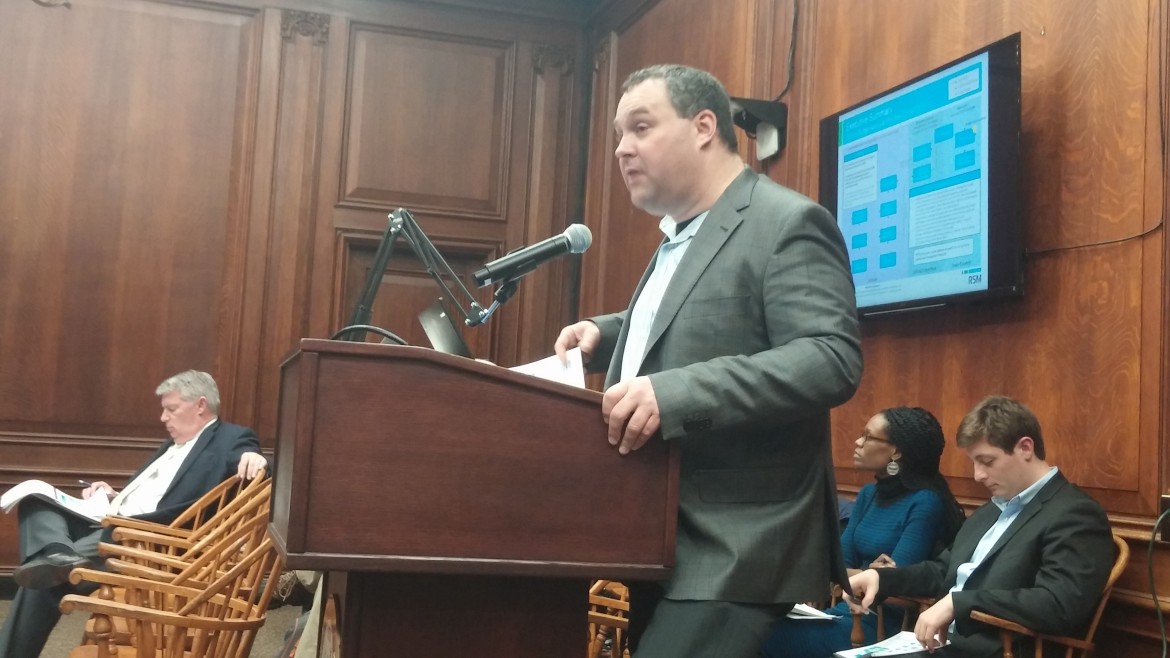
Charlie Breitrose
Craig Finley of RSM presented a report looking at the Watertown Schools’ financial practices, special education and more.
A consultant hired to review the financial mishaps of the Watertown Public Schools from a couple years ago presented recommendations to improve financial practices and also looked deeply at the special education program – a high cost area for the district.
Monday night, the School Committee and Town Council received the report from RSM US. The group interviewed more than 50 people and spent months working on the report, said Craig Finley, the project lead.
While there are nearly 30 recommendations (see the report here) to improve what’s being done in the Watertown schools, Finley said in general they are in good shape.
“The biggest thing we foundation here is strong support of the schools,” said Finley, who worked in public schools, including as an assistant superintendent in the Whitman-Hanson Regional School District.
The biggest challenge facing the district is its aging school buildings and lack of space. Finley said the district should continue to pursue money from the state’s Massachusetts School Building Authority to help pay for new schools or renovation of the existing ones.
The report also found that the top administrators were taking on too much, and it recommended the Business Services Director be elevated to an assistant superintendent position, and that the other assistant superintendent oversee teaching and learning.
Members of the School Committee and Town Council thanked Finley and RSM for their report. Some members, however, wanted to see more details, including what questions were asked, and more detailed data in the findings.
With a long list of recommendations, Councilors and School Committee members also wanted to know if they could be achieved in the three year timeline set by RSM.
“Absolutely,” said Finley, who recommended the Council and School Committee have a joint committee to track the progress.
Financial Practices
The study looked at Fiscal Years 2014 and 2015, a time when the Watertown Public Schools operated without a business manger. Since that time the district hired Charles Kellner as director of Business Services.
During the time of the study, however, the school’s system of accounting fell apart.
“In the two years we looked at expenditures were not classified correctly,” Finley said. “There was spending from an account because there was money in an account (without a transferring it first). The problem is the historical data is out the window.”
When they observed the budget process last year with Kellner onboard, Finley said, it was much improved.
A recommendation was made to come up with a formal policy for budget transfers to make it more transparent and clear to staff.
Also, the consultants recommended the district update formal business and accounting process policy guide, and monitoring weekly deposits to strengthen internal controls and to clarify responsibilities.
The town and schools created a Special Education Stabilization Fund, but does not have a policy for how and when to access the money, so Finley said a policy should be created.
Special Education
One of the biggest problem in the district’s special education program is the turnover of the director. This raises the cost because of what must be spent on the search and hiring a new director, but also leads to interruptions in the program.
“The procedure gets muddled,” said Mildred O’Callaghan, a special education consultant for RSM. “You want to make sure you keep the person so you keep a consistent philosophy.”
The district is close to hiring the new special education director, School Committee Chairman John Portz said.
The study compared Watertown to the state average spending by school districts and found overall, Watertown is 11 percent higher than the state average, but the out-of-district special education costs are 113 percent higher than the average
Part of that is due to the fact that Watertown had specialized private schools such as Perkins School for the Blind in town or nearby, Finley said. If a student moves to Watertown to attend Perkins (or other specialized schools), the district must pick up the cost of educating that student.
O’Callaghan noted that Watertown had some students requiring unusually high-cost programs move in during the years they studied.
“An anomaly happened where four students moved in and cost over $600,000,” O’Callaghan said. “The chances of that happening again is low. I hope it never does, but you can’t predict those sorts of things.”
To cut down the out-of-district costs, O’Callaghan said the schools should look for opportunities to bring students back to Watertown, such as grouping students with like needs (i.e. autism, behavioral problems) and create a program in the district. Another option would be placing them in such a program in a nearby district.
Cost Saving Opportunities
One recommendation from RSM was to look at ways the town and the schools can combine efforts so they do not have separate departments doing the same thing, Finley said.
Some areas that other districts and towns have combined include facilities, information technology (IT) and financial services. Finley recommended Watertown look at combining facilities departments. He noted there is already some sharing of services for IT an financial services, and he did not recommend combining the finance departments because the schools need their own director.
Watertown offers the same amount of professional development for all faculty, but some school districts do not give the full amount each year. Finley said this is something that Watertown officials could explore.
The district has more instructional aides than most, so O’Callaghan recommended researching why each aide has been hired and make sure the person is needed.